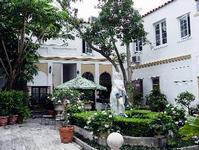
A commercial courtyard in Miami, USA. - Photo by Rita Elliott
Courtyards are private open spaces surrounded by walls or buildings. They have been in use for almost as long as man has lived in constructed dwellings (instead of caves). The earliest known courtyard houses were built in India and China and date as far back as 3000 BC.
Before the appearance of courtyards, open fires were kept burning in a central place within a home, with only a small hole in the ceiling overhead to allow smoke to escape. Over time, these small openings were enlarged and eventually led to the development of the centralised open courtyard we know today.
Courtyard homes are perhaps more prevalent in hot climates, as an open central court can be an important aid to cooling house in warm weather.
In the East
Courtyard houses in the Middle East reflect the nomadic influences of the region. Instead of officially designating rooms for cooking, sleeping, etc., these activities were relocated throughout the year as appropriate to accommodate the changes in temperature and the location of the sun. Often, the flat rooftops of these structures were used for sleeping in warm weather. In some Islamic cultures, private courtyards provide the only outdoor space for women to relax unobserved.
The traditional Chinese courtyard house is an arrangement of several individual houses around a square. Each house belongs to a different family member, and additional houses are created behind this arrangement to accommodate additional family members as needed. The Chinese courtyard is a place of privacy and tranquillity, almost always incorporating a garden and water feature.
The central uncovered area in a Roman home was referred to as an atrium. Today, we generally use the word atrium to describe a glass-covered courtyard. Roman atrium houses were built side by side along the street. They were one-storey homes without windows that took in light from the entrance and from the centre atrium only.
The medieval European farmhouse is one of the best examples of a courtyard house - four buildings arranged around a square courtyard with a steep roof covered by thatch. The central courtyard was used for working, gathering, and sometimes keeping small livestock. An elevated walkway frequently ran around two or three sides of the courtyards in the houses. Such structures afforded protection, and could even be made defensible.
In the West
In the first half of the 20th century, a trend developed in Los Angeles, USA, around courtyard houses. Well-known designers developed houses that only visually appeared to copy Mediterranean architecture, but using very carefully planned courtyards managed to create both a sense of community, safety and scale. Using various levels of private/public gradations these courtyard houses were so successful that they have been copied throughout the western coast of the United States.
Courtyards and patios are often confused. Here is the basic difference:
Patios: The word comes from the Spanish - 'patio,' meaning 'back garden' or 'backyard.' It refers to an outdoor garden space generally used for dining or recreation that often adjoins a residence. Typically, it is paved and designed around the use of large clay pots.

